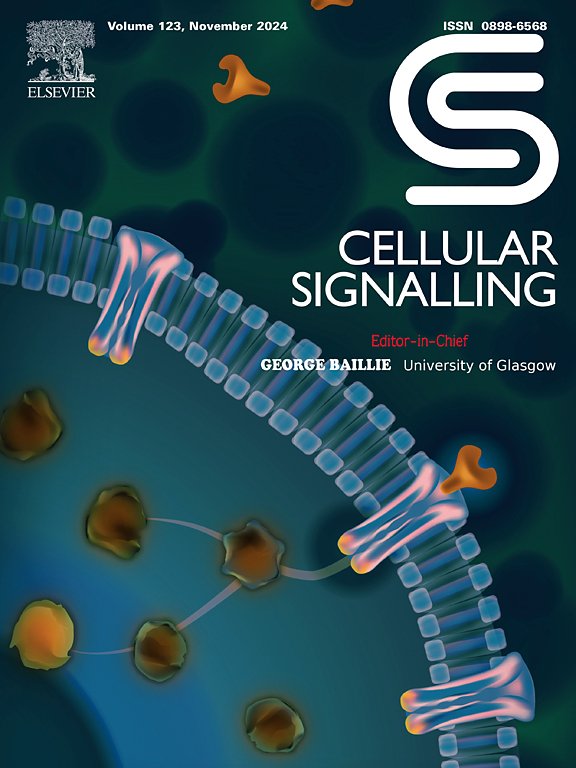Rab27a+CAF exosomal miR-9-5p promotes osteosarcoma progression via CREBRF/MAPK signaling pathway
IF 3.7
2区 生物学
Q2 CELL BIOLOGY
引用次数: 0
Abstract
Osteosarcoma is the most common primary malignant bone tumor in adolescents, characterized by high rates of recurrence and chemotherapy resistance. Exosomes, as key mediators of intercellular communication, have emerged as potential biomarkers and therapeutic targets in cancer. However, the mechanisms by which cancer-associated fibroblasts (CAFs) exosomal miRNAs regulate osteosarcoma progression remain unclear. This study investigates the role of exosomal miR-9-5p derived from Rab27a+CAF in promoting osteosarcoma malignancy via CREBRF/MAPK (Mitogen-Activated Protein Kinase) signaling axis. Serum and tissue derived exosomes were isolated, followed by small RNA sequencing and validation of miR-9-5p expression using qRT-PCR (quantitative RT-PCR). Single-cell RNA sequencing was performed on osteosarcoma and adjacent tissues to characterize the tumor microenvironment. The interaction between exosomal miR-9-5p and CREBRF was confirmed using dual-luciferase reporter assays. CCK8 (Cell Counting Kit 8), Edu (5-Ethynyl-2′-deoxyuridine), cell cycle, and cell apoptosis in vitro were conducted to explore the function of exosomal miR-9-5p/CREBRF/MAPK signaling pathway on osteosarcoma. The tumorigenicity of CAF exosomal miR-9-5p was assessed using a subcutaneous osteosarcoma mouse model. Exosomal miR-9-5p was significantly upregulated in serum and tissue from osteosarcoma patients and was associated with poor prognosis. Single-cell RNA sequencing revealed that Rab27a+CAF were major contributors in the tumor microenvironment. Functional assays demonstrated that exosomal miR-9-5p promoted proliferation, cisplatin resistance, cell cycle progression, and inhibited apoptosis in osteosarcoma cells. Mechanistically, miR-9-5p targeted and downregulated CREBRF, thereby activating the MAPK signaling pathway. Experiments in vivo confirmed that high levels of exosomal miR-9-5p enhanced tumor growth and MAPK pathway activity. This study identifies Rab27a+CAF exosomal miR-9-5p as a key oncogenic factor in osteosarcoma, which promotes tumor progression and chemoresistance by suppressing CREBRF and activating the MAPK pathway. These findings highlight exosomal miR-9-5p as a promising biomarker and therapeutic target for precision treatment of osteosarcoma.

Rab27a+CAF外泌体miR-9-5p通过CREBRF/MAPK信号通路促进骨肉瘤进展
骨肉瘤是青少年最常见的原发性恶性骨肿瘤,具有高复发率和化疗耐药的特点。外泌体作为细胞间通讯的关键介质,已成为癌症的潜在生物标志物和治疗靶点。然而,癌症相关成纤维细胞(CAFs)外泌体mirna调节骨肉瘤进展的机制尚不清楚。本研究探讨了来自Rab27a+CAF的外泌体miR-9-5p通过CREBRF/MAPK(丝裂原活化蛋白激酶)信号轴促进骨肉瘤恶性发展的作用。分离血清和组织来源的外泌体,然后进行小RNA测序,并使用qRT-PCR(定量RT-PCR)验证miR-9-5p的表达。对骨肉瘤及其邻近组织进行单细胞RNA测序以表征肿瘤微环境。外泌体miR-9-5p和CREBRF之间的相互作用通过双荧光素酶报告基因检测得到证实。通过体外CCK8 (Cell Counting Kit 8)、Edu(5-乙基-2′-脱氧尿苷)、细胞周期、细胞凋亡等检测,探讨外泌体miR-9-5p/CREBRF/MAPK信号通路在骨肉瘤中的作用。使用皮下骨肉瘤小鼠模型评估CAF外泌体miR-9-5p的致瘤性。在骨肉瘤患者的血清和组织中,外泌体miR-9-5p显著上调,并与不良预后相关。单细胞RNA测序显示Rab27a+CAF是肿瘤微环境的主要贡献者。功能分析表明,外泌体miR-9-5p促进骨肉瘤细胞的增殖、顺铂耐药、细胞周期进展,并抑制细胞凋亡。在机制上,miR-9-5p靶向并下调CREBRF,从而激活MAPK信号通路。体内实验证实,高水平的外泌体miR-9-5p可促进肿瘤生长和MAPK通路活性。本研究发现Rab27a+CAF外泌体miR-9-5p是骨肉瘤的关键致癌因子,通过抑制CREBRF和激活MAPK通路促进肿瘤进展和化疗耐药。这些发现强调了外泌体miR-9-5p作为一种有希望的生物标志物和精确治疗骨肉瘤的治疗靶点。
本文章由计算机程序翻译,如有差异,请以英文原文为准。
求助全文
约1分钟内获得全文
求助全文
来源期刊

Cellular signalling
生物-细胞生物学
CiteScore
8.40
自引率
0.00%
发文量
250
审稿时长
27 days
期刊介绍:
Cellular Signalling publishes original research describing fundamental and clinical findings on the mechanisms, actions and structural components of cellular signalling systems in vitro and in vivo.
Cellular Signalling aims at full length research papers defining signalling systems ranging from microorganisms to cells, tissues and higher organisms.
 求助内容:
求助内容: 应助结果提醒方式:
应助结果提醒方式:


